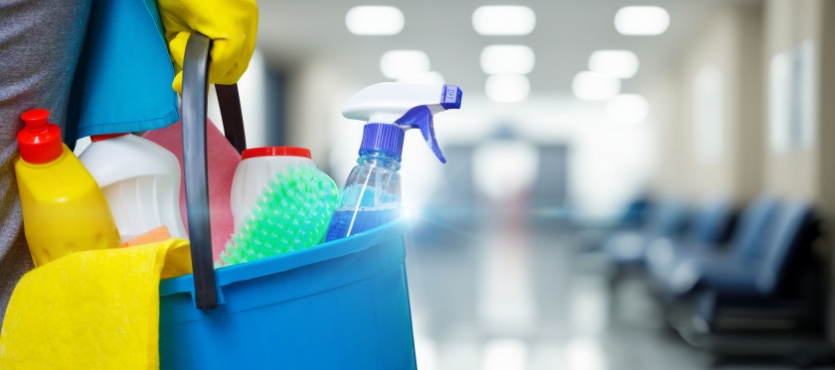Healthcare facilities, such as hospitals, clinics, and medical offices, are environments where cleanliness and hygiene are not just a matter of aesthetics but of life and death. The potential for the spread of infections in healthcare settings is high, making thorough and regular cleaning essential for safeguarding both patient and staff health. Proper cleaning practices reduce the risk of healthcare-associated infections (HAIs) and help ensure compliance with health and safety regulations. This blog explores the critical role cleaning plays in healthcare environments and offers strategies to maintain the highest standards of cleanliness for patient and staff safety.
Why Cleaning in Healthcare Facilities is Critical
Preventing Healthcare-Associated Infections (HAIs): Healthcare-associated infections are one of the most serious concerns in medical settings. Patients, especially those with compromised immune systems, are at heightened risk of contracting infections from contaminated surfaces, medical equipment, and the environment. According to the Centers for Disease Control and Prevention (CDC), approximately 1 in 31 hospital patients acquires at least one healthcare-associated infection.
Regular and thorough cleaning of patient rooms, operating theaters, and high-touch surfaces significantly reduces the transmission of pathogens. Disinfection of surfaces such as bed rails, door handles, medical instruments, and restrooms is vital to minimize the risk of HAIs, including infections like MRSA, C. difficile, and surgical site infections.
Maintaining Sterile Environments: Certain areas of healthcare facilities, such as operating rooms and intensive care units, require a sterile environment to protect patients undergoing surgeries and other high-risk procedures. A failure to maintain proper sanitation in these areas can result in severe infections or complications. Specialized cleaning methods, such as terminal cleaning (a deep cleaning performed after patient discharge), ensure that these spaces are thoroughly disinfected and safe for the next patient.
Protecting Healthcare Workers: Healthcare professionals are frequently exposed to various pathogens during their daily activities. Cleaning and disinfection of workspaces, break rooms, restrooms, and medical equipment protect healthcare workers from contracting infections. In turn, a healthy workforce ensures that hospitals and clinics can operate efficiently, avoiding staffing shortages caused by illness.
Key Areas for Cleaning in Healthcare Facilities
High-Touch Surfaces: High-touch surfaces, such as bed rails, IV poles, door handles, and light switches, are some of the most common sources of contamination in healthcare settings. These surfaces come into frequent contact with patients, visitors, and staff, making them high-risk areas for spreading infections. Regular and consistent disinfection of these areas is crucial for preventing cross-contamination.
Restrooms and Patient Bathrooms: Restrooms in healthcare facilities can harbor a significant number of germs and bacteria, especially when shared by patients or visitors. Cleaning these areas frequently with hospital-grade disinfectants ensures the removal of harmful bacteria that can spread infections. This includes cleaning toilets, sinks, faucets, and any other surfaces that may be contaminated.
Medical Equipment and Tools: Proper cleaning and sterilization of medical equipment, such as stethoscopes, thermometers, and surgical instruments, are vital for patient safety. Inadequately sanitized equipment can introduce bacteria, viruses, and fungi into vulnerable patients, leading to infections. Following established sterilization protocols, such as those outlined by the World Health Organization (WHO) and the CDC, is crucial for medical staff and cleaning teams.
The Benefits of Professional Cleaning Services in Healthcare Settings
Professional cleaning services for healthcare facilities have the expertise and knowledge needed to maintain a sterile environment. These companies use medical-grade cleaning products and equipment designed to eliminate harmful pathogens effectively. Additionally, trained cleaning staff are familiar with healthcare regulations and best practices, ensuring that healthcare facilities meet the required standards for cleanliness and safety.
Healthcare facilities are subject to strict regulatory standards set by organizations such as the Occupational Safety and Health Administration (OSHA), the Joint Commission, and the CDC. Failure to comply with these standards can result in penalties, legal liabilities, or damage to the facility’s reputation. Professional cleaning services help ensure that all areas of the facility are cleaned according to these regulatory guidelines.
A clean and well-maintained healthcare environment contributes to positive patient experiences. Patients are more likely to feel safe and comfortable in a facility that prioritizes cleanliness, which can lead to improved satisfaction and trust in their care. Additionally, healthcare workers benefit from a clean and organized workspace, reducing stress and helping them focus on providing the best possible care.
Partnering with Tidy Team Cleaning Services for Healthcare Safety
Ensuring the cleanliness of healthcare facilities is critical to patient safety, staff well-being, and infection control. By focusing on high-touch surfaces, medical equipment, and sterilization of key areas, healthcare providers can significantly reduce the risk of infections and improve overall safety.
Tidy Team Cleaning Services provides professional cleaning solutions tailored to healthcare environments. Our expert team understands the unique challenges of cleaning medical facilities and is equipped with the skills and products necessary to meet strict healthcare standards. Contact us today to learn how we can help ensure that your healthcare facility maintains the highest level of cleanliness and safety for patients and staff alike.

